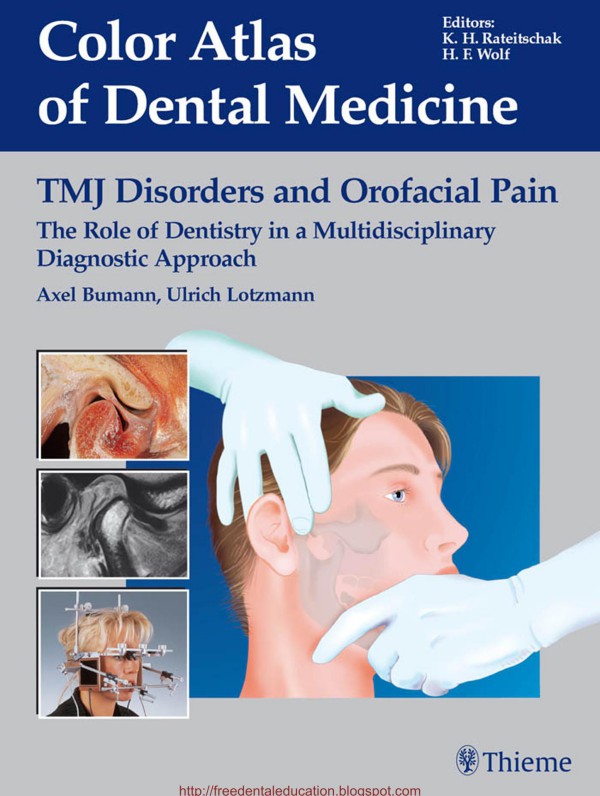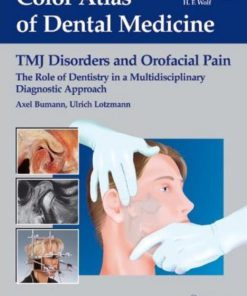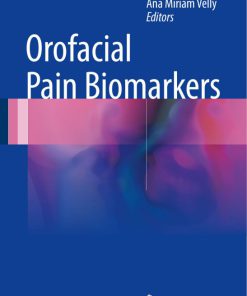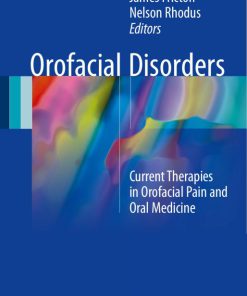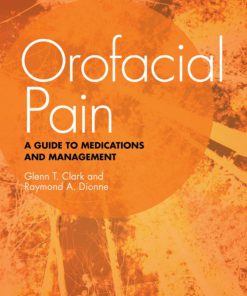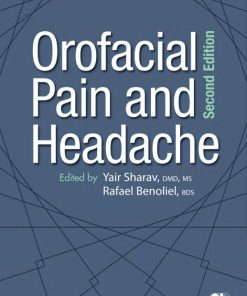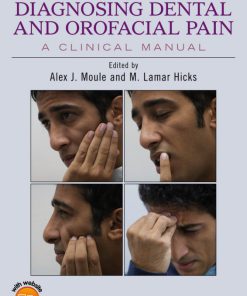TMJ Disorders and Orofacial Pain 1st Edition by Axel Bumann,Ulrich Lotzmann,James Mah 9783131605610 3131605618
$50.00 Original price was: $50.00.$25.00Current price is: $25.00.
Authors:Bumann, Axel; Ulrich Lotzmann , Author sort:Bumann, Axel; Ulrich Lotzmann
TMJ Disorders and Orofacial Pain 1st Edition by Axel Bumann,Ulrich Lotzmann,James Mah – Ebook PDF Instant Download/Delivery.9783131605610,3131605618
Full download TMJ Disorders and Orofacial Pain 1st Edition after payment
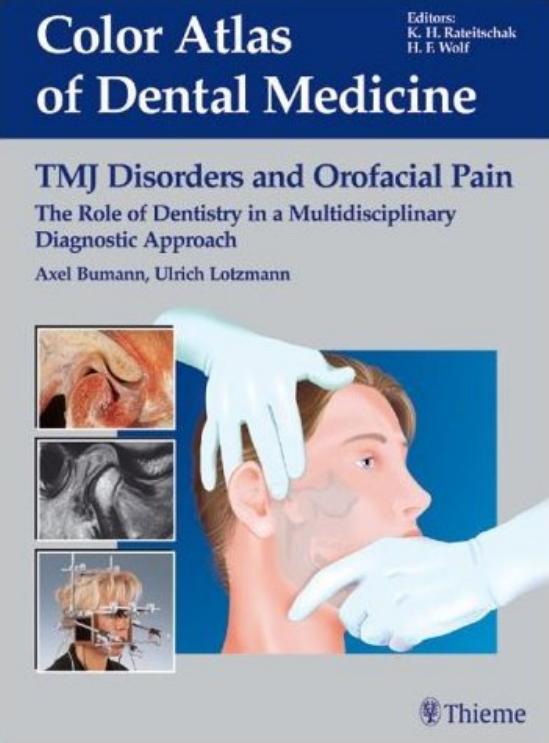
Product details:
ISBN 10:3131605618
ISBN 13:9783131605610
Author:Axel Bumann,Ulrich Lotzmann,James Mah
Provides a key multidisciplinary approach–including interpreting MRIs for dentists!
The treatment of temporomandibular disorders requires a multidisciplinary approach, involving the participation of dentists, oral and maxillofacial surgeons, radiologists, and others. This lavishly illustrated text/atlas provides a wealth of valuable information for specialists who need to enhance their understanding of TMJ disorders.
TMJ Disorders and Orofacial Pain is the invaluable diagnostic guide all dentists and related specialists need to provide optimize the care and treatment of patients in this condition. It ties together the anatomic, physiologic, and psychological aspects of TMJ to help you confidently reach an accurate diagnosis.
MRI has proven to be the most reliable imaging modality for the diagnosis of TMJ disorders. A key benefit of this text is teaching dentists how to interpret MRIs, and also to provide the required knowledge for informed communication with radiologists.
Throughout the text, you’ll find exquisitely detailed, full-color photographs which take you step-by-step through the clinical examination of the jaw. The book teaches you how to analyze information as it comes in to select the proper course of treatment based on the patient’s history and clinical data.
Written in a clear and easy-to-follow format, the text presents state-of-the-art approaches to managing TMJ disorders. With this book, dentists and related specialists will gain the essential skills and knowledge needed to ensure their patients receive the best possible care!
TMJ Disorders and Orofacial Pain 1st Table of contents:
The Masticatory System as a Biological System
Progressive/Regressive Adaptation and Compensation/Decompensation
Functional Diagnostic Examination Procedures…
…and their Therapeutic Consequences
The Role of Dentistry in Craniofacial Pain
Primary Dental Evaluation
Findings in the Teeth and Mucous Membrane
Overview of Dental Examination Techniques
Anatomy of the Masticatory System
Embryology of the Temporomandibular Joint and the Muscles of Mastication
Development of the Upper and Lower Joint Spaces
Glenoid Fossa and Articular Protuberance
Mandibular Condyle
Positional Relationships of the Bony Structures
Articular Disk
Anatomical Disk Position
Bilaminar Zone
Joint Capsule
Ligaments of the Masticatory System
Arterial Supply and Sensory Innervation of the Temporomandibular Joint
Sympathetic Innervation of the Temporomandibular Joint
Muscles of Mastication
Temporal Muscle
Masseter Muscle
Medial Pterygoid Muscle
Suprahyoid Musculature
Lateral Pterygoid Muscle
Gross Anatomical and Histological Studies of the Masticatory Muscle Insertions
Force Vectors of the Muscles of Mastication
Tongue Musculature
Muscles of Expression
Temporomandibular Joint and the Musculoskeletal System
Peripheral and Central Control of Muscle Tonus
Physiology of the Jaw-Opening Movement
Physiology of the Jaw-Closing Movement
Physiology of Movements in the Horizontal Plane
The Teeth and Periodontal Receptors
Condylar Positions
Static Occlusion
Dynamic Occlusion
Manual Functional Analysis
The Masticatory System as a Biological System
Specific and Nonspecific Loading Vectors
Examination Form for Manual Functional Analysis
Patient History
Positioning the Patient
Manual Fixation of the Head
Active Movements and Passive Jaw Opening with Evaluation of the Endfeel
Differential Diagnosis of Restricted Movement
Examination of the Joint Surfaces
Manifestations of Joint Surface Changes
Conducting the Clinical Joint Surface Tests
Examination of the Joint Capsule and Ligaments
Clinical Significance of Compressions in the Superior Direction
Examination of the Muscles of Mastication
Palpation of the Muscles of Mastication with Painful Isometric Contractions
Areas of Pain Referred from the Muscles of Mastication
Length of the Suprahyoid Structures
Investigation of Clicking Sounds
Active Movements and Dynamic Compression
Manual Translations
Dynamic Compression during Retrusive Movement
Differentiation among the Groups
Differentiation within Group 1
Differentiation within Group 2
Differentiation among Unstable, Indifferent, and Stable Repositioning
Differentiation within Group 3
Differentiation within Group 4
Unified Diagnostic Concept and…
…Treatment Plan for Anterior Disk Displacement
Tissue-Specific Diagnosis
Principles of Manual Functional Analysis
Protocol for Cases with Pain
Protocol for Clicking Sounds
Routine Protocol
Protocol for Limitations of Movement
Primary and Secondary Diagnoses
Investigation of the Etiological Factors (Stressors)
Neuromuscular Deprogramming
Mandibular and Condylar Positions
Static Occlusion
Dynamic Occlusion
Bruxism Vector or Parafunction Vector
Dysfunctional Movements
Influence of Orthopedic Disorders on the Masticatory System
Supplemental Diagnostic Procedures
Mounted Casts, Axiography
Panoramic Radiograph
Lateral Jaw Radiograph
Joint Vibration Analysis (JVA)
Musculoskeletal Impediments in the Direction of Treatment
Manual Functional Analysis for Patients with no History of Symptoms
Imaging Procedures
Panoramic Radiographs
Portraying the Temporomandibular Joint with Panoramic Radiograph Machines
Asymmetry Index
Distortion Phenomena
Eccentric Transcranial Radiograph (Schüller Projection)
Axial Cranial Radiograph According to Hirtz and Conventional Tomography
Posterior-Anterior Cranial Radiograph according to Clementschitsch
Lateral Transcranial Radiograph
Computed Tomography of the Temporomandibular Joint
Computed Tomography of the Temporomandibular Joint and its Anatomical Correlation
Three Dimensional Images of the Temporomandibular Joint…
…with the Aid of Computed Tomography Data
Three-Dimensional Reconstruction for Hypoplastic Syndromes
Three-Dimensional Models of Polyurethane Foam and Synthetic Resin
Magnetic Resonance Imaging
T1- and T2-Weighting
Selecting the Slice Orientation
Practical Application of MRI Sections
Reproduction of Anatomical Detail in MRI
Visual (Qualitative) Evaluation of an MR Image
Classification of the Stages of Bony Changes
Disk Position in the Sagittal Plane
Disk Position in the Frontal Plane
Misinterpretation of the Disk Position in the Sagittal Plane
Morphology of the Pars Posterior
Progressive Adaptation of the Bilaminar Zone
Progressive Adaptation in T1 – and T2-Weighted MRIs
Disk Adhesions in MRI
Disk Hypermobility
Partial Disk Displacement
Total Disk Displacement
Types of Disk Repositioning
Disk Displacement without Repositioning
Partial Disk Displacement with Total Repositioning
Partial Disk Displacement with Partial Repositioning
Total Disk Displacement with Total Repositioning
Total Disk Displacement with Partial Repositioning
Condylar Hypermobility
Posterior Disk Displacement
Disk Displacement during Excursive Movements
Regressive Adaptation of Bony Joint Structures
Progressive Adaptation of Bony Joint Structures
Evaluation of Adaptive Changes: MRI Versus CT
Avascular Necrosis Versus Osteoarthrosis
Metric (Quantitative) MRI Analysis
Examples of Bumann’s MRI Analysis
MRI for Orthodontic Questions
Three-Dimensional Imaging with MRI Data
Dynamic MRI
Cine MRI
Movie MRI
MR Microscopy and MR Spectroscopy
Indications for Imaging Procedures as Part of Functional Diagnostics
Prospects for the Future of Imaging Procedures
Mounting of Casts and Occlusal Analysis
Making of Impressions and Stone Casts
Fabrication of Segmented Casts
Registration of Centric Relation
Techniques for Recording the Centric Condylar Position
Transcutaneous Nerve Stimulation for Muscle Relaxation—”Myocentric*’
Interocclusal Registration Materials
Centric Registration for Intact Dentitions
Occlusal Splints used as Record Bases
Centric Registration for Posteriorly Shortened Dental Arches
Jaw Relation Determination for Edentulous Patients
Mounting the Casts in the Correct Relationship to the Cranium and Temporomandibular Joints
Attaching the Anatomical Transfer Bow
Mounting the Maxillary Cast using the Anatomical Transfer Bow
Mounting the Maxillary Cast using a Transfer Stand
Mounting the Maxillary Cast following Axiography
Mounting the Mandibular Cast
Axiosplit System
Split-Cast Control of the Cast Mounting
Check-Bite for Setting the Articulator Joints
Effect of Hinge Axis Position and Thickness of the Occlusal Record on the Occlusion
Occlusal Analysis on the Casts
Occlusal Analysis Using Sectioned Casts
Diagnostic Occlusal Reshaping of the Occlusion on the Casts
Diagnostic Tooth Setup
Diagnostic Waxup
Condylar Position Analysis using Mounted Casts
Instrumented Analysis of Jaw Movements
Mechanical Registration of the Hinge Axis Movements (Axiography)
Evaluating the Axiograms and Programming the Articulator
Hinge Axis Tracings (Axiograms) as Projection Phenomena
Effect of an Incorrectly Located Hinge Axis on the Axiograms
Electronic Paraocclusal Axiograpy
Diagnoses and Classifications
Classification of Primary Joint Diseases
Classification of Secondary Joint Diseases
Hyperplasia, Hypoplasia, and Aplasia of the Condylar Process
Hyperplasia of the Coronoid Process
Congenital Malformations and Syndromes
Acute Arthritis
Rheumatoid Arthritis
Juvenile Chronic Arthritis
Free Bodies within the Joints
Styloid or Eagle Syndrome
Fractures of the Neck and Head of the Condyle
Disk Displacement with Condylar Neck Fractures
Fibrosis and Bony Ankylosis
Tumors in the Temporomandibular Joint Region
Joint Disorders—Articular Surfaces (International Classification of Diseases, 9th Rev.)
Joint Disorders—Articular Disk
Joint Disorders—Bilaminar Zone and Joint Capsule
Joint Disorders—Ligaments
Muscle Disorders
Principles of Treatment
Specific or Nonspecific Treatment?
Nonspecific Treatment
Elimination of Musculoskeletal Impediments
Occlusal Splints
Splint Adjustment for Vertical Disocclusion and Posterior Protection
Relationship between Joint Surface Loading and the Occlusal Scheme
Relaxation Splint
Stabilization Splint
Decompression Splint
Repositioning Splint
Verticalization Splint
Definitive Modification of the Dynamic Occlusion
Definitive Alteration of the Static Occlusion
Examination Methods and Their Therapeutic Relevance
Illustration Credits
People also search for TMJ Disorders and Orofacial Pain 1st :
a tmj disorder treatment that would be considered irreversible
tmj and orofacial pain clinic
tmj disorders orofacial pain center
tmj and orofacial pain programs
a tmj decompression procedure is performed in which anatomical area
You may also like…
eBook PDF
Orofacial Pain Biomarkers 1st edition by Jean Paul Goulet,Ana Velly 9783662539941 3662539942

